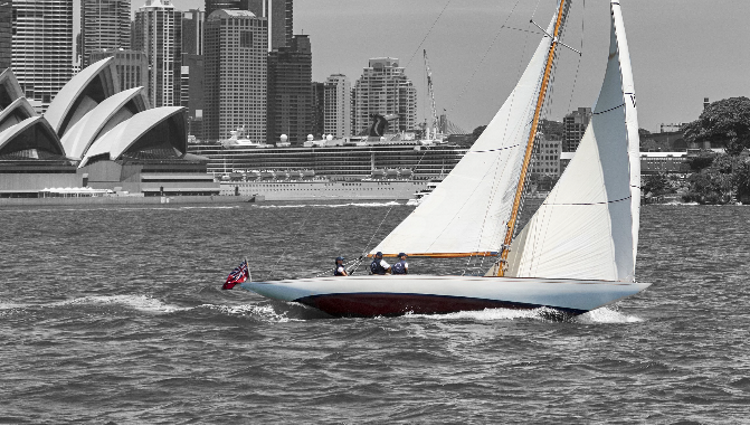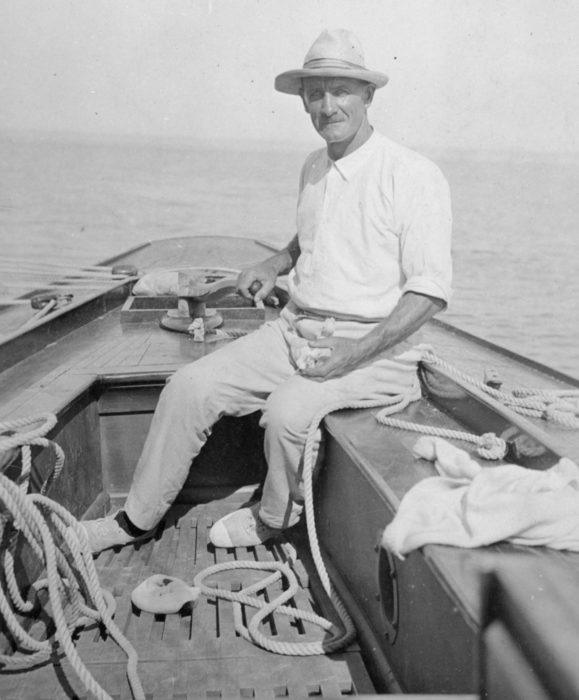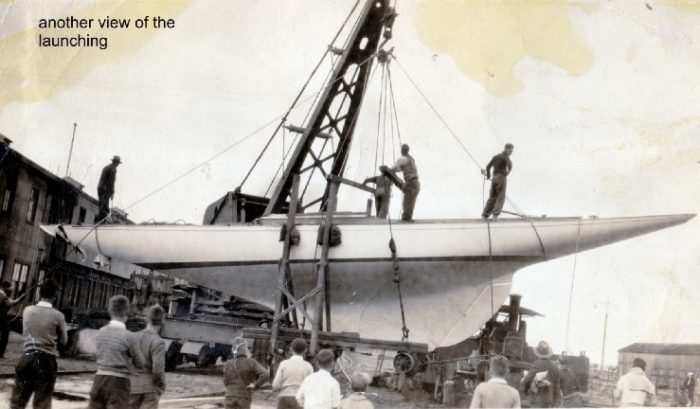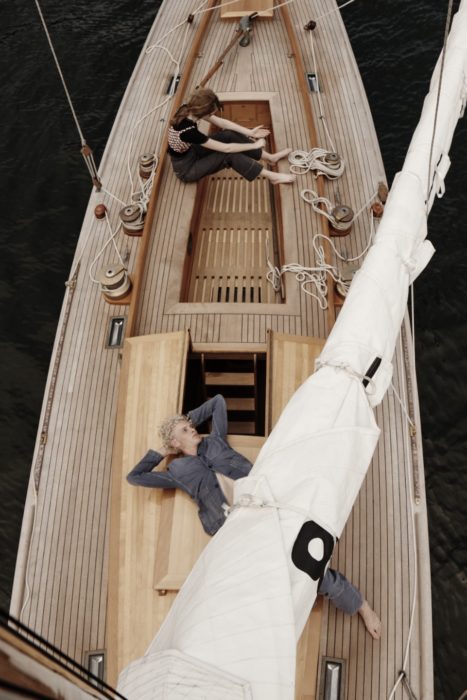
Sail Number: 11
Vessel Type: 8mR (3rd & last version)
LOA: 48’6″ / 14.78m – LOD: 48’6″ / 14.78m – LWL: 32’0″ / 9.75m – Beam: 9’6″ / 2.90m – Draft: 6′6″ / 1.98m – Displacement: – Sail Area: – Built By: Ernest O Digby, Williamstown, Victoria, Australia – Designed by: Ernest O Digby – Launched: 1935 – Original owner: Ernest Olney Digby ‘Old Dig’ – Original name: Defiance – Engine: – Vessel Number: HV000742 – Flag: Australia – Homeport: Sydney
Historical:
“Defiance was launched with great excitement in 1935. The beautiful yacht was a beacon of hope, of singular courage and vision to all.” – Nicole Grace Shrimpton
From the Australian Register of Historic Vessels, managed by the Australian National Maritime Museum.
DEFIANCE was the second of three large yachts that Ernest Digby designed and built in the 1920s, 30s and 40s. The gaff rigged cutter INDEPENDENCE was the first, launched in 1920 and described as 38 feet LOA., it carried a substantial gaff rig sailplan. It would have been designed to the 2nd version of the International Rule. From what is recorded of INDEPENDENCE it raced in the A class against EU NA MARA in its early days, and later the Fife designed 8 metre VANESSA. February 1920 yachting notes of its first race indicate it was in the” VGRA 9 Metre class”. FRANCES (HV000622) was his third and final yacht and it too was designed to rate and race as an 8 metre. FRANCES had a famous career including winning the Sayonara Cup. It is not known if Digby built DEFIANCE for the Sayonara Cup racing as well, or perhaps for the Olympics in 1936 where the 8 metre class was involved in the yachting events. The Depression era had made it hard to maintain local interest and participation in either of these events. The Sayonara Cup was not raced from 1932 until 1950, and Australia was not able to take part in yachting events in the Olympics until after World War 2. Whatever was the case, DEFINACE had plenty of competition in the A Class with ACROSPIRE and EU NA MARA.
As a sailor Digby was well respected, as this quote from Sporting Globe 2nd March 1932 when he was sailing INDEPENDENCE in 1932 indicates;
“Ernie Digby is one of our best and most popular yachtsmen, and one who ls always ready to give a helping hand where needed.”
DEFIANCE was built at Digby’s own home in Victoria St Williamstown, not far up the street from the bay. It was planked in Queensland kauri pine, with a hardwood stem and a spruce pole mast supporting its tall gaff topsail sloop rig. The International Rule it was designed to was the primary rule used in Europe and UK for measuring, rating and handicapping yachts, and Australia adopted the rule and its subsequent versions from 1907 onwards. By 1935 it had stabilized to become Version 3, and this produced many years of fine sailing craft in the 6, 8 and 12 metre class craft and remains the final version of the rule. The rule is relatively complex with a number of specific hull measurement points and requirements that relate to the location and length of the craft’s actual waterline when it is floated, along with a number of minimum or maximum dimensions. It requires careful design, and an allowance for a range of possible trimmed waterlines to deliver a design that will be able to rate to the intended class.
The Northcote Cup had adopted the 6 metre rule and some boats were built locally to international designs, such as CULLWULLA, or were designed and built in Australia. In the bigger rating classes, Charlie Peel was the first Australian designer to design yachts to the rule in Australia. He designed and built two craft ACROSPIRE III and IV to race in the Sayonara Cup against Fife and Anker 8 metre class designs either imported or built in Australia. Unfortunately his craft came out with much higher ratings, and did not measure as 8 metres. It is not known what rating Digby’s first design INDEPENDANCE achieved, but the records show that DEFIANCE was referred to as an 8 metre, so DEFIANCE must have been rating at or very close to the required 8 metre outcome. In addition it complied with the requirement for the International Rule yachts to be constructed according to Lloyds Rules for yachts, ensuring it had strong scantlings. DEFIANCE measures in with a longer waterline than is average for the 8 metre class.
Ernest Digby’s boats were a celebration of wooden boat building featuring the Australian timbers of the day. The resourceful shipwright was an enthusiastic collector of timbers, particularly during the Depression years. DEFIANCE featured his many ‘finds’ including hanging knees fashioned from the crooks of tea tree.
The coach house is composed of Huon pine with a kauri edge, the strong floors displaying the burl of celery top pine. The original deck, now replaced with teak for longevity, would have most likely have been of Australian kauri, as was the original coverboard at the deck edge. Quantities of Australian kauri are now miniscule, although new forests have been planted there is not enough to replicate the deck. Unlike the Scandinavian 8 metres of Anker and the British designs with their luxurious cabinetry and varnished kingplanks, the Digby 8’s are relatively uncluttered and have a certain dignity in their purity. Digby’s signature was one of robust strength and simplicity, softened by champhored edging, simple pull holes and plank seating.
Early reports show that it was raced in the A class on Port Phillip with success. And is understood to have won seven of its first twelve races. Launched late in 1935 DEFIANCE’s first race was on the 4th January 1936. The Williamstown Chronicle 8 Feb 1936 reported its next race.
Yacht Club Regatta
There were several thrills during the racing at the’ Hobson’s Bay Yacht Club’s regatta last Saturday afternoon. The ACROSPIRE III nearly collided with an outgoing steamer. Varying winds and uncertain conditions caused the confusion and several yachts passed dangerously close to outgoing steamers.
Mr Digby’s- 8-metre, racing yacht, DEFIANCE won the Al class handicap at the Hobson’s Bay club’s regatta last Saturday. He built the vessel at his home in Victoria Street, and it is the only 8-metre yacht designed and built in Australia and by an Australian, complying in every detail with Lloyd’s regulations.”
A race in March provided some different reporting- The Argus 23 March 1936 was quite short with its story.
“DÉFIANCE AGAIN
A light northerly made conditions Ideal for the yachting events held at St Kilda, Brighton and Williamstown on Saturday At St Kilda DEFIANCE was successful again In the Al class event”
However the Sporting Globe 25th March went into more detail, and was effusive in its praise for the yacht.
Defiance does it once more, by H.C. Brooke
With a splendid exhibition of helmsman ship in a shifty breeze, Ernie Digby again brought his new eight-metre yacht, DEFIANCE, home in pride of place at St Kilda on Saturday. Always on the right tack in the varying puffs, he took the lead from Bernie .Snider’s EUN-NA-MARA, on the first long, beat, and maintained it to the end, to win the race by more than 3 minutes.
This performance, following her victory on the previous Saturday in the heavy going, must be very satisfactory to her owner and, crew. It also serves as a complete answer to those critics who, just after her launching, looked her over scornfully, and pointed out several imaginary faults. I would not be so rash as to compare her hull for hull with that beautiful creation of Fifes, VANESSA but in the capable hands of her present skipper, I feel there would be days when she would provide staunch opposition”
However a month later the same correspondent HC Brooke writes a piece about two races clearly won by Digby and DEFIANCE, yet he praises another yacht’s performance throughout citing luck as the reason the outcome was different. In the Sporting Globe 15 April 1936:
“Although DEFIANCE was successful in the two big yachting events during Easter, the long distance race from St.Kilda to Queenscliff, and a race at Queenscliff — the honours of the sailing went to Commodore J. White’s ACROSPITE IV. She was defeated by adverse luck in tidal waters. According to Barney Snider, popular owner-skipper of EUN-NA-MARA, ACROSPIRE was the best performer in each race. She worked out a good lead in the early stages of the first race and was only headed by DEFIANCE after that boat received a favourable slant the south. The choice of Cole’s channel instead of the west channel, and the dodging of a strong flood tide, further increased DEFIANCE’s lead, and she went on to win with ease. EUN-NA-MARA. who was under-crewed, and could not set her topsail, was the only other boat to finish”

Caught by Tide
ACROSPIRE IV. appeared a sure winner of the second event, but due to being caught in a strong tide, and practically no wind, she was passed by both DEFIANCE and EUN-NA-MARA on the last leg of the course and finished well astern. Queenscliff is a tricky place for yacht racing.”
Perhaps Digby’s skill in reading the difficult wind and tidal conditions had a strong bearing on the outcome. DEFIANCE and Digby were still racing with success in later years, as noted in The Argus 20 March 1939.
“DEFIANCE Wins Well
A light southerly barely strong enough to sail yachts provided difficulties and in a test of skill in seven events at the Royal Brighton carnival on Saturday DEFIANCE gave a good performance In the Al class handicap race and finished only 2 min 13scc behind ACROSPIRE IV the champion boat, but it gained first place on corrected time with PETREL second and ACROSPLRE IV third.”
The war intervened and yacht racing was abandoned while boat builders joined the war effort on the home front. After the war Digby set about rebuilding his business and eventually set his sights on a new yacht, FRANCES. In 1946 DEFIANCE was taken under a new owner FA Bullock to begin a long connection to Sydney and the east coast, where it remains today. It attempted to break the sailing record from Melbourne to Sydney in what was probably the delivery voyage, but was unfortunately becalmed off Wollongong delaying its finish and leading to concerns in the press about the crew potentially starving. A member of the crew on this voyage was a young N. K. Wran of Balmain (New South Wales Premier 1976 to 1986).
Under three different owners it went five times to Hobart. Known as the ‘offshore 8,’ it was the only 8 Metre to sail in this prestigious offshore event. DEFIANCE placed 3rd overall in the second Sydney to Hobart in 1946, and was disqualified in 1947, when it and a later winner, CHRISTINA, hit the starter’s boat and under the rules of the day without any alternate penalty available they were disqualified. It apparently led CHRISTINA all the way to the fickle Derwent and was ultimately disqualified only for not reporting the incident rather than being in the wrong. In fact the starting rules were amended after this race.
The Sydney Morning Herald (SMH) on 16 April 1949:
“DEFIANCE was first across the finishing mark yesterday in the 86-mile ocean sailing race from Sydney to Jervis Bay. Defiance (F. Bullock) crossed the line at 6.12 p.m., according to the timekeeper for the race, Mr. V. Leeson. No other yachts were in sight at 9.45 p.m.”
It was a decisive win and other high places were to come.
The SMH on 4 Oct 1949:
Defiance may be First Yacht Home
Leaders in the Royal Prince Alfred Yacht Club’s 350-mile Montagu Island yacht race, Defiance and the scratch boat Kyeema, were off Sydney Heads early this morning. Defiance was thought to be leading. She had a good chance of winning the race on handicap.”
KYEEMA, a larger almost 10 metre rating yacht eventually won, but in later races against KYEEMA, PAKERDOO and other large yachts DEFIANCE had its time as victor.
In July 1951 it had a new owner Fred Harris, who converted DEFIANCE to a Bermudan sloop rig and went ocean racing in the yacht. A later owner was Nelson Rundle of Newcastle who did the 1954 Hobart race with DEFIANCE and kept up the yacht’s colourful ocean racing career.
The next chapter was when Anne and Alan Hinds bought DEFIANCE in 1960. From Anne’s perspective it was something of a love affair. Writing in some detail on the www.mysailing.com website she noted how they bought DEFIANCE “because we knew how fast and exciting the Eights were, but also because she offered what seemed at the time to be good accommodation for a family with three small children, then aged five, three and 12 months. Unlike most of the other Eights she had been fitted out for ocean-racing, with luxuries like six berths, an ice chest, a sink and a gimballed stove; quite an innovation when installed in 1947!
Alan took her to Pittwater and raced regularly at the Royal Prince Alfred Yacht Club against two other Eights, Pakerdoo and Varg, in the Number One division for a number of years. But our real love was cruising with the family and mucking around in Broken Bay and Cowan Creek and that’s what we did for about five decades and never tired of it. We sailed to Sydney often for Christmas with extended family, to watch the boats heading off to Hobart and to see the Queen arrive aboard Britannia (a stinking southerly if I remember rightly) and to watch various of the America’s Cup trials. We had a memorable cruise to Port Stephens, when the crew were a little older (eight, six and four) but most of our time was spent in the Hawkesbury estuary.
So how have I loved my boat?
Firstly, it is a beautiful experience to helm an eight metre; the tiller responds to a finger touch. You can feel quite directly the power of the boat; you are intimately connected to the wind and the water and the elegant hull slicing her way.
DEFIANCE was a hand built boat and has very slight imperfections, like a beautiful woman or a work of art. On the starboard tack the boat sails to windward with almost no correction from the tiller needed, but on the port tack there is just a suggestion of weather helm. DEFIANCE has a will of her own.”
The ‘affair” with DEFIANCE has continued, and its current owner has put considerable effort into overhauling the yacht and bringing it back to an inshore racing configuration, and Naval Architect Andy Dovell has confirmed it will measure in as an 8 metre.
The current owner bought DEFIANCE with the intention of bringing the boat back to inshore racing on Sydney Harbour, restoring the boat’s to Ernest Digby’s original 1935 racing and cabin layout in the hands of third generation shipwright Colin Beashel. For ease of handling, the Bermudan rig common to the 8 metre class has been retained, with an engine removable for strict competition.
With FRANCES in Melbourne and DEFIANCE in Sydney, Ernest Digby’s pair of 8 metres continue as champions, the gun-boats of their classic fleets both in NSW and Victoria and displaying the advantages of the metre boat amidst a younger mixed fleet.
In Division 1 on Australia Day 2015, DEFIANCE was steered to victory by the legendary Gordon Ingate OAM and came third overall on Australia Day 2017, with first places in twilight racing out of the Royal Sydney Yacht Squadron, beating a mixed division of newer boats home squarely by four minutes, and in the Classic Division out of the Sydney Amateur Sailing Club with a resounding victory of a clear twelve minutes over her nearest rival, the 9 Metre JOSEPHINE. Numerous wins in her debut season post-restoration, have been at the hands of leading international yachtsman and big-boat specialist Harold Cudmore. “I have found DEFIANCE to have a very good balance at different angles of heal which means it is easier to keep tracking upwind as wind strength varies,” he observed. “This feature is beneficial and not always achieved by other boats. It indicates the designer had a feeling for how a boat built to the International rule should work. “
Pre-eminent Sydney harbour sailor, and the owner of the first of the Ranger series Bill Gale, said of Defiance “She is the most exciting boat I have ever sailed.” In the 2017 winter racing DEFIANCE won the Combined Clubs Classics division skippered by David Giles.
Reflecting on why she loves her boat so much and spent so much money on her, Nicole Shrimpton said, “Because to me she is a classic even amongst classics. From the moment I saw her I have been compelled, perhaps beyond reason and rationale, to restore and preserve her. And to honour the memory of an extraordinary man in Ernest Digby, surely one of the great unsung heroes of early yacht design in Australia. One day I saw the great architect Rick Le Plastrier drinking in her lines and I totally understood. To us she is pure beauty. My heart skips every time I see her on the harbour, whether onboard or from afar. Helming her is of course one of the great pleasures of life. In the process of handover, the late Alan Hinds said he felt Defiance was in ‘good hands’. I have tried to honour the trust implied in that statement.
One is always the custodian, rather than ‘owner,’ of a classic boat and each will bring their own stamp. My mission has always been to restore her and bring her back to racing. To feel her sailed well in the hands of champions such as Prince Phillip and World Cup winner David Giles, Olympian Carly Ryves, Dick Sargent and Sydney to Hobart winner the late Roger Hickman has been my greatest delight and I salute all who have her helped her sail this far. DEFIANCE is a piece of exquisite Australian history and all I want is for her to continue gracing our waterways long after I am gone.”
Provenance. (The Wall of Remembrance – The Owners, Crew & Notable Guest):
- Owner (1935-1945) – E.O Digby
- Owner (1945) – Frank A. Bullock
- Owner E.A. Harris
- Owner Nelson D. Rundle, Lake Macquarie
- Owner Alan B. & Dr. Ann Hinds and N. G Shrimpton., Pittwater (Royal Prince Alfred Yacht Club)
- Owner (2012) – Nicole Shrimpton, underwent restorations in 2014–2016 at Colin Beashel Marine in Elvina Bay Pittwater
- Race crew: Georges Brenac
- Race crew: Joe Palmer
- Race crew: Mick York
- Race crew: Gordon Ingate
- Race crew: Olympian Dick Sargeant
Resources:
- The Australian Register of Historic Vessels, managed by the Australian National Maritime Museum.
- The International Eight Metre Association
- Australia’s First 8, by Nicole Grace Shrimpton



